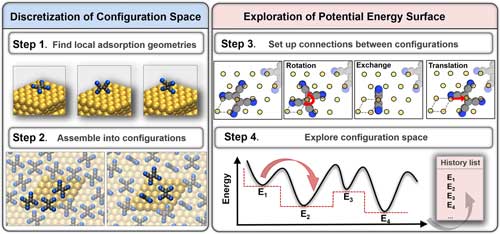| Posted: Jul 01, 2017 | |
Innovative computational approach to overcome combinatorial bottleneck in material science(Nanowerk News) Researchers in Austria have introduced SAMPLE (surface adsorbate polymorph prediction with little effort), an innovative computational structure search algorithm to explore the potential energy landscape of organic/inorganic interfaces upon first-principles. |
|
| The team's approach, reported in Nano Letters ("Structure Prediction for Surface-Induced Phases of Organic Monolayers: Overcoming the Combinatorial Bottleneck"), combines a systematic discretization of the PES with an efficient exploration realized as a Monte Carlo method inspired by the Basin-Hopping algorithm. | |
 |
|
| SAMPLE approach: A systematic discretization of the configuration space consisting of an extensive set of supramolecular configurations (left) is followed by an exploration of the PES, where efficiently chosen configurations are relaxed to the corresponding polymorphs, that is, the nearest local minima on the PES (right). The outcome is a set of energetically lowest lying polymorphs. Specifically, Step 1 shows three out of the nine stable local adsorption structures for TCNE/Au(111), that is, a flat-lying TCNE molecule, an upright-standing TCNE molecule with the central C=C bond parallel to the surface, and equivalently perpendicular to the surface. Step 2 depicts two possible configurations generated by the assembly process. In Step 3, exemplary trial moves are illustrated, that is, translation by one primitive surface unit cell (which is indicated by the dashed box), rotation, and exchange by another local adsorption geometry. Step 4 shows a schematic PES (black line) and the corresponding transformation into a set of interpenetrating staircases (red dashed line) by performing local geometry optimizations. Because of the unique labeling of all configurations, a history list containing all visited polymorphs can be provided. (© ACS) (click on image to enlarge) | |
| SAMPLE represents a powerful and efficient computational structure search algorithm that allows to employ fully converged first-principles calculations throughout. It is specifically designed to explore the potential energy landscape of commensurate organic/inorganic interfaces with large unit cells containing multiple molecules and to efficiently and accurately locate low-energy polymorphs. | |
| This allows to predict global minima (in cases where the experimental growth process is thermodynamically controlled), and furthermore also provides a set of relevant, low-energy structures that are useful to verify the interpretation of experiments. | |
| In stark contrast to commonly applied global structure search techniques, in a first assembly process they a priori generate a complete and enclosed configuration space with a well-defined and reproducible number of possible configurations. | |
| In a subsequent exploration step, an efficiently chosen set of energetically low-lying polymorphs including the thermodynamic minimum is predicted. Our approach is inspired by traditional Basin-Hopping but is generally more efficient. | |
| The discretization is designed such that the resulting configuration is already very close to a local minimum, ensuring that the consecutive local geometry optimization is highly efficient. | |
| Furthermore, the team's method allows to efficiently revisit and cross already known parts of the configuration space without any additional computational effort, as the first assembly process enables the unique labeling of each polymorph. | |
| The efficiency is particularly enhanced by applying systematic trial moves according to carefully chosen transition rules, instead of the commonly applied random trial moves. | |
| The researchers benchmarked their approach on the example of TCNE/Au(111) by interfacing SAMPLE with dispersion-corrected DFT and validated the predicted global minimum by comparison to the experimental STM data. | |
| Besides demonstrating the efficiency and power of the SAMPLE approach, they could moreover provide an alternative interpretation that cannot be inferred from pure experimental data. | |
| These aspects endow the SAMPLE approach with significant potential for refined structure determination and prediction of other interface materials far beyond the system discussed in this paper. |
 By
Michael
Berger
– Michael is author of three books by the Royal Society of Chemistry:
Nano-Society: Pushing the Boundaries of Technology,
Nanotechnology: The Future is Tiny, and
Nanoengineering: The Skills and Tools Making Technology Invisible
Copyright ©
Nanowerk LLC
By
Michael
Berger
– Michael is author of three books by the Royal Society of Chemistry:
Nano-Society: Pushing the Boundaries of Technology,
Nanotechnology: The Future is Tiny, and
Nanoengineering: The Skills and Tools Making Technology Invisible
Copyright ©
Nanowerk LLC
|
|
|
Subscribe to a free copy of one of our daily Nanowerk Newsletter Email Digests with a compilation of all of the day's news. |
